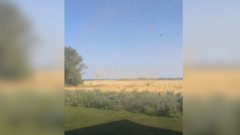
The world’s oldest known meteor showers will be visible again this weekend, whizzing past at 30 miles per second.
The Royal Greenwich Observatory said this year, the Lyrids will be visible from April 16 to April 25, peaking on April 22.
Once a year, the Earth passes through the trail left by the comet C/1861 G1 Thatcher, creating the oldest recorded meteor shower still visible after it was first spotted in 687 BCE.
Its name comes from the Lyra constellation, where they appear to originate from in the sky, but in reality have nothing to do with the distant stars.
The sky will light up as the meteor whizz past at around 30 miles per second, moving so fast the air particles in front can’t get out of the way in time.
Instead, they’re rapidly compressed and start to heat up, raising the temperature around the meteor to as high as 1,600 C° – causing it to shine brightly as it streaks across the sky.
Here’s everything you need to know about them.
When is the best time to see the Lyrid meteor shower?

The Lyrids began on April 16 and will be visible until April 25, peaking on April 22.
To have the best chance of seeing them, check the skies on April 22.
How to watch the Lyrid meteor shower
Greenwich Observatory said the best way to see the showers is at a dark site with an unobstructed view of the sky, but the number of meteors will depend on factors such as the amount of light pollution.
The Lyrids are visible with the naked eye, so no specialist equipment is needed to watch the spectacle.
The observatory added: ‘While the Lyrid meteors will be visible all across the sky, following their path backwards, they will appear to originate from the constellation of Lyra, the lyre, which contains the star Vega.
‘In realit,y the meteors have nothing to do with this distant group of stars. The direction they appear to come from is dictated by the motion of the Earth and the debris itself.
‘All of the meteors are coming in approximately parallel to one another, like lanes of traffic on a straight motorway. Our perspective makes them appear to travel sideways across the sky.
‘Just as a person standing on the central reservation of the motorway will have cars pass on either side of them, the meteors will appear to diverge from the so-called radiant point in Lyra and streak across the sky in all directions.’
Get in touch with our news team by emailing us at [email protected].
For more stories like this, check our news page.







.jpg.webp?itok=1zl_MpKg)





 Bengali (Bangladesh) ·
Bengali (Bangladesh) ·  English (United States) ·
English (United States) ·